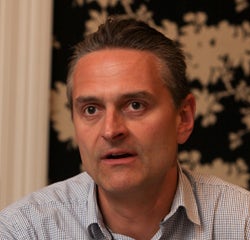Financial services marketers discuss their customer-centric strategies
Financial services brands are racing to become more customer-centric after several years of economic turmoil but face tough challenges, not least from the unique regulatory environment in which they operate. Marketing Week brought together eight marketing experts from across the sector to debate responses to those challenges, and discuss how brands are reacting to new channel opportunities.

(Above, l-r) Ruth Mortimer, editor of Marketing Week (chair)
Charlie Gower, head of research and insight, Hiscox
Kelvin Godhard, senior marketing manager, HSBC
Mark Iremonger, chief strategy officer, iCrossing
Mark Raymond, account director, iCrossing
Richard Doe, CEO ING Direct, (previously CMO)
Alex Bannister, head of customer marketing, Nationwide
Christopher White, former head of marketing and sectors and regions, RBS
Sion O’Connor, marketing director, Vanquis Bank

Marketing Week (MW): Would you agree that financial services brands have shifted from marketing specific products and services to focusing on what customers need overall?
Alex Bannister (AB): There is an inherent tension between selling or hitting financial targets and any longer term ‘meeting customer needs’ conversation that might take place. Customers are generally not looking to switch banking product unless they’ve had a problem or a product has reached maturity, which fuels the bank’s desire to engage them when they get a rare opportunity.
Mark Iremonger (MI): The idea of being customer centric in financial services seems to be about improving the customer experience. As a consumer, banks only engage with me when there is a new product or service. Generally, if they try and engage on any other level, it feels like there’s a secret sell going on.
Richard Doe (RD): The trouble in the financial sector is the products aren’t things people actually want; they regard them as either a necessary evil or a means to an end. Particularly with insurance, protection or lending.
Christopher White (CW): Since 2007-08, RBS has tried to re-engineer itself to become more customer centric. It’s a very long road, and we’re only just getting started. We’re trying to understand and engage with [our corporate] clients a great deal better than we’ve done in the past by understanding issues that they’re facing within their specific sector, which is not something that the bank would have considered doing five years ago.
Sion O’Connor (SO): There has been a great revolution in servicing; it’s sometimes about the way you will service a product than the core product itself. There is a need today for immediacy and wider social trends have changed the role of financial services.
Kelvin Goddard (KG): New entrants like Metro Bank, Virgin and Marks & Spencer are capitalising on those new trends. I don’t think the products are that innovative but they are differentiating on product immediacy and their service.

MW: Will the new entrants, such as M&S Bank or Metro Bank, make a big impact on consumers?
Charlie Gower (CG): They aren’t hampered by legacy systems, and can do what customers want – which is walk out and use something straight away [like a debit card]. They don’t want the 13 or 14 letters that tend to come with a [debit card] PIN!
RD: Research shows that people typically trust banks above retailers to handle their financial affairs. Also there is quite a gulf between people’s personal experiences and the generic view of banks, and politicians and the media.
KG: In terms of brands and how you change customer perceptions, I think that’s where the opportunity for the new players comes in because they don’t have the baggage. They offer very similar products, but can offer different touchpoints.
MW: Is there a job to rebuild trust in financial services?
Richard Doe (RD): It seems every five to ten years, something horrific happens in the financial sector. Banks are happy to sell a product because it is highly profitable. In many cases, banks know there is a risk in selling that product, which is not only the loss through a customer not paying back or getting your pricing wrong, but also reputational risk and regulatory risk, which is what ends up being damaging to the sector. It will be interesting to see any research on this – all of those customers claiming over [misselling of] Payment Protection Insurance (PPI), how many are changing their bank? I suspect it’s low.
MI: There is quite a discussion about the separation of retail and the diverse corporate operations within banks. I wonder if it’s an opportunity for them to reset their relationship with consumers?
CW: [Separation] works for NatWest, because most people don’t know it’s part of RBS. The levels of satisfaction are greater than for RBS so from a branch perspective that could work. And frankly, there are some people who think the whole retail function of RBS should be put through NatWest.
MW: Are you using new channels, such as social media, to talk to customers?
RD: We monitor Twitter so we can respond to any customer communication. But during the time it takes us to work out how to respond with proper clearance, the customer service team have phoned the customer and sorted them out, so by the time you’ve got through all the various approvals, it’s been sorted out. So the practicalities are very difficult.
Mark Raymond (MR): Virgin Media do it quite well. If you phone its customer services then you could be waiting for a while but if you tweet the company with your number, it will phone you back within a few mins, so you can circumvent the whole tedious wait.
KG: We use Facebook to try and create a community for student customers, so they don’t just feel like banking customers but part of something bigger. From a wider transactional perspective, social media is almost unsupportable because of compliance and regulation about what we can and can’t say – it’s really nervous territory for us.
RD: Where social media is particularly useful is where there is a crisis. In 2008, we collaborated with [consumer affairs website] MoneySavingExpert to input into its forums in order to communicate with stressed customers we had just acquired following the purchase of two Icelandic banks. It was a good use of social media – where you’re getting a message to a large and engaged group of people in the most effective possible way.
AB: We do Facebook and Twitter. We talk about house prices and some things which border on marketing, but without general engagement. For us we have 15 million customers and its the more traditional channels that take up half of our time. Face-to-face meetings between customers and directors once a month, a new customer panel, and we also do all the usual things around tracking service and talking to thousands of customers a year to understand what could be better.

CW: We are held back by regulation that says we can’t give advice. If something you say to a consumer online is seen as advice you then have to ask: does it have all the appropriate warnings, has it been filtered and so on. Then it becomes irrelevant because it’s so warning-heavy you can’t get it into 140 characters!
CG: The aggregator websites have created a race to the bottom and stripped out all the value in the insurance sector. It has become a commodity market where you have all the madness of meerkats in ads, nodding dogs – whatever gimmick you need to get attention – which is educating customers to switch annually. That means you can have no history with a customer and can’t understand the risk involved.
MW: How do you measure the success of your relationships with customers?
RD: We try to have a system where the person you speak to [in customer services] is always able to deal with your call rather than always transferring you away. Also, we have given call centre staff the ability to compensate customers there and then, and what we have seen compensation go down because complaints are being dealt with more quickly in one go rather than having to go through a complaints procedure.
KG: We have restructured recently from channel-specific to activity-specific teams. This means we can step in between the lawyers [checking everything fits regulations] and the customer. The reason we have this new approach is to make sure lawyers aren’t talking to customers.
SO: To get our staff to understand our customers better, we did a piece of work where we created six to eight typical customer personas. It was a real lightbulb moment for non-operational people, like people in IT, to bring those people to life and give them a sense of who they’re creating all these systems for.
AB: At the highest level, customer satisfaction is one of the critical key performance indicators for senior management. Right now, we have a target that if we achieve a certain amount, we’ll get an extra month’s bonus for everybody.





